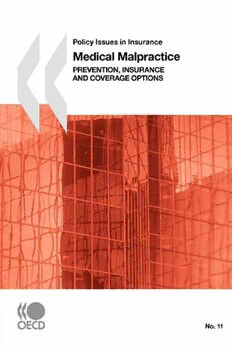
Policy Issues in Insurance No. 11 Medical Malpractice: Prevention, Insurance and Coverage Options (Policy Issues in Insurance) PDF
85 Pages·2007·8.073 MB·English
Most books are stored in the elastic cloud where traffic is expensive. For this reason, we have a limit on daily download.
Preview Policy Issues in Insurance No. 11 Medical Malpractice: Prevention, Insurance and Coverage Options (Policy Issues in Insurance)
Description:
Confidence in a countrys health care system requires indemnification and deterrence systems that adequately cover liability, provide fair compensation for injury, and deter medical malpractices. Over the last years, in many OECD countries, these systems have experienced difficulties resulting in high-risk specialty physicians and surgeons leaving the practice and the development of expensive and uselessif not riskydefensive medicine. This publication surveys and assesses various types of mechanisms and reforms that best limit and indemnify medical accidents. Reasons for difficulties faced by some compensation and prevention regimes, given the specificities of national circumstances and in particular of health care systems, are examined. The study offers a series of unique and focused policy options for establishing more efficient indemnification and deterrence systems to cope with medical accidents.Table of Content : Introduction: A Supply ""Crisis"" in Some Countries Chapter 1. Coping with Medical Malpractice in OECD Countries -Differences in the System of Compensation for Medical Malpractice in OECD Countries -All Systems are Experiencing Difficulties at Various Degrees -Worrying Effects Chapter 2. Driving Factors -Expanding Risk: Evidence of Medical Error? -Escalating Damages Resulting from Both Increased Frequency and Severity of Claims -Insurability Concerns Chapter 3. No One-Fold Solution -Enhancing Risk Insurability -Seeking Alternatives to Enhance Capacity Supply through Market Solutions -Complementary or Stand-Alone Market/Policy Options -Conclusion Chapter 4. Suggested Policy Options -Remaining in the Framework of a Litigation System Combined with Medical Malpractice Insurance Coverage -Opting for a Comprehensive No-Fault System -Enhancing Medical Risk Management Selected References Annex A. Comparative Tables on the Coverage and Compensation of Medical Malpractice in OECD Countries
See more
The list of books you might like
Most books are stored in the elastic cloud where traffic is expensive. For this reason, we have a limit on daily download.
